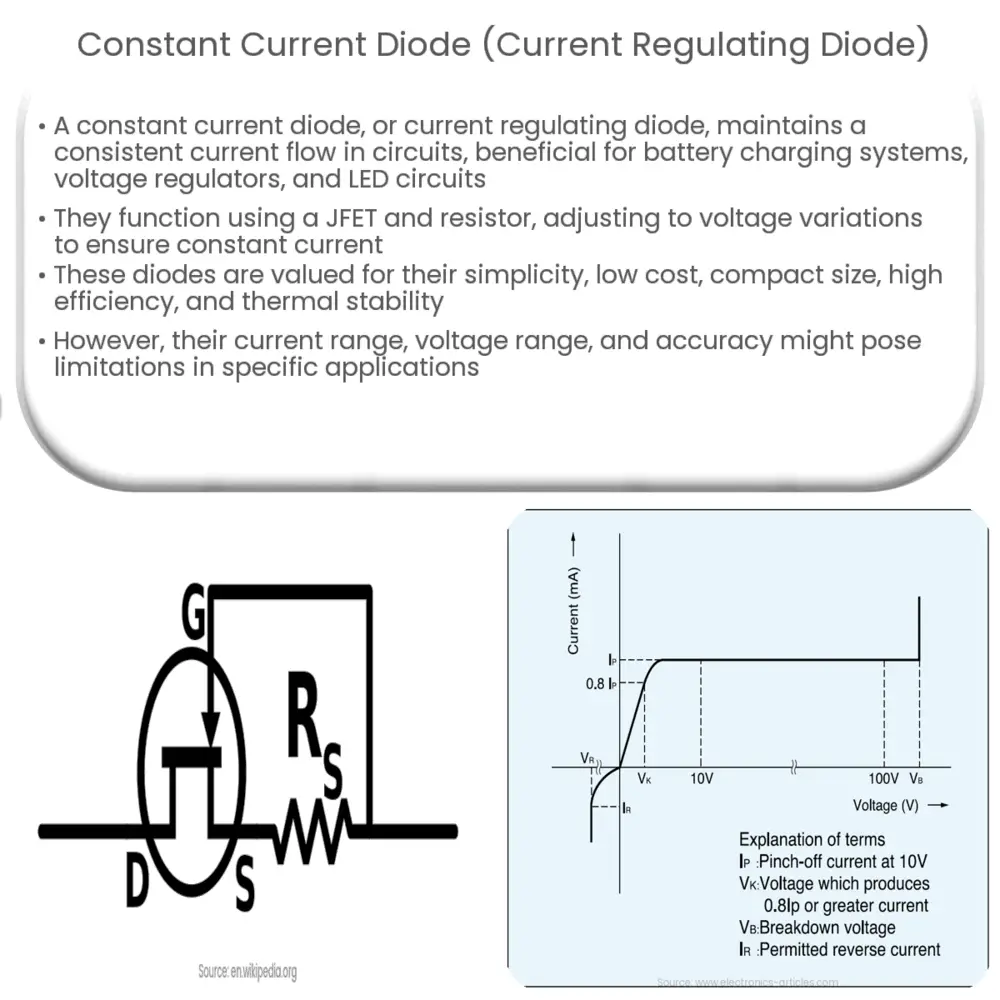A constant current diode is a semiconductor device that maintains a stable current flow in circuits, used in battery charging, voltage regulation, and LED circuits.

Constant Current Diode: Understanding Current Regulating Diodes
A constant current diode, also known as a current regulating diode, is an electronic component that functions as a passive device to maintain a constant current flow through a circuit. This ability to maintain a stable current is particularly useful in various applications, including battery charging systems, voltage regulators, and LED circuits. In this article, we will discuss the working principle of constant current diodes and their applications in electronic circuits.
Working Principle of Constant Current Diodes
Constant current diodes are semiconductor devices that operate in a similar fashion to traditional diodes, allowing current to flow in one direction (forward bias) while blocking current flow in the opposite direction (reverse bias). However, the primary difference between a constant current diode and a traditional diode is that the former is designed to maintain a constant current flow across a range of voltages.
This functionality is achieved through the use of a JFET (Junction Field Effect Transistor) and a resistor connected in series. The JFET serves as a current-limiting component, while the resistor is used to set the desired current level. When a voltage is applied across the diode, the JFET starts conducting, and the voltage drop across the resistor increases. As the voltage drop reaches a certain threshold, the JFET enters saturation, limiting the current flow through the circuit. This results in a constant current output that is relatively independent of the input voltage variations.
Applications of Constant Current Diodes
Constant current diodes are used in a wide range of applications due to their ability to maintain a stable current flow in a circuit. Some of the most common applications include:
- Battery Charging Systems: In battery charging circuits, it is crucial to maintain a constant current flow to ensure that the battery is charged at a steady rate. Constant current diodes can be used to regulate the charging current, preventing overcharging and improving battery life.
- Voltage Regulators: Constant current diodes can be employed in voltage regulator circuits to provide a stable output voltage, regardless of input voltage fluctuations. This is achieved by using the constant current diode to maintain a fixed current flow through a voltage divider network.
- LED Circuits: LEDs require a constant current for optimum performance and to prevent damage due to overcurrent. Constant current diodes can be used in LED driver circuits to ensure that the current flowing through the LED remains constant, regardless of any variations in the input voltage or temperature.
- Current Sources: Constant current diodes can be used to create a simple current source for various electronic applications, including biasing circuits and reference current sources for analog circuits.
In summary, constant current diodes are versatile electronic components that play a vital role in maintaining stable current flow in various applications. Their ability to regulate current flow across a range of voltages makes them indispensable in numerous electronic circuits.
Advantages of Constant Current Diodes
Constant current diodes offer several benefits when compared to other current regulating devices, such as linear or switching regulators. Some of these advantages include:
- Simplicity: Constant current diodes are relatively simple devices, requiring fewer components for operation. This simplicity makes them easy to implement in electronic circuits, even for those with limited experience in electronics.
- Low Cost: Due to their simple construction and the use of inexpensive components, constant current diodes are generally more cost-effective than other current regulating solutions.
- Small Size: Constant current diodes have a small form factor, making them suitable for use in space-constrained applications.
- High Efficiency: Unlike linear regulators, constant current diodes do not dissipate excess power as heat, resulting in higher overall efficiency.
- Thermal Stability: The current regulating properties of constant current diodes are relatively insensitive to temperature variations, ensuring consistent performance over a wide temperature range.
Limitations of Constant Current Diodes
Despite their many advantages, constant current diodes do have some limitations that should be considered when designing electronic circuits:
- Current Range: Constant current diodes are typically designed for specific current ranges, which may limit their applicability in some situations. It is essential to choose the appropriate diode for the desired current level.
- Voltage Range: The operating voltage range of constant current diodes may be limited, requiring careful consideration of input voltage variations in the circuit design.
- Accuracy: While constant current diodes can maintain a relatively stable current flow, their accuracy may not be as high as other current regulating devices, such as precision current sources or high-performance linear regulators.
Conclusion
Constant current diodes are valuable electronic components that offer a simple and cost-effective solution for maintaining a stable current flow in various applications. Their ease of implementation, small size, and high efficiency make them a popular choice for many circuit designers. However, it is essential to carefully consider the limitations of constant current diodes and choose the appropriate device for the desired application.
By understanding the working principle, applications, advantages, and limitations of constant current diodes, engineers and hobbyists alike can make informed decisions when incorporating these devices into their electronic circuits. With the right implementation, constant current diodes can significantly improve the performance and reliability of various electronic systems.

